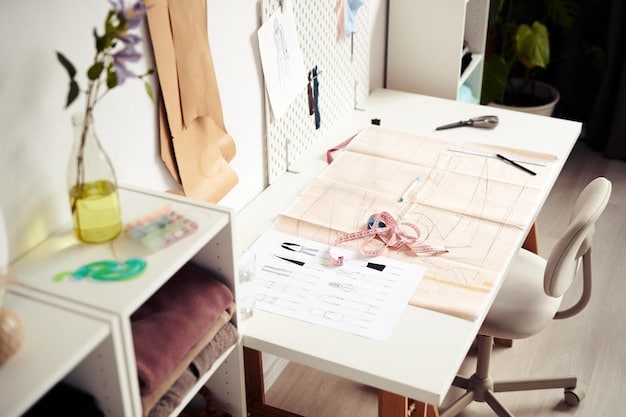How to Get Noticed by Top US Fashion Designers: Insider Tips

Getting noticed by top US fashion designers requires a strategic approach involving networking, showcasing unique talent, and building a strong online presence to stand out in a competitive industry.
Breaking into the fashion industry and capturing the attention of top US designers can feel like an insurmountable challenge. How to Get Noticed by Top US Fashion Designers: Insider Tips for Aspiring Professionals involves more than just talent; it requires strategic networking, a compelling portfolio, and a strong understanding of the current fashion landscape.
Understanding the US Fashion Landscape
To make a real impact, knowing the ins and outs of the US fashion scene is crucial. It’s not just about having a great design sense, but also understanding the market dynamics, key players, and evolving trends that shape the industry.
Key Fashion Centers in the US
The US fashion industry is multifaceted, with each major hub offering unique opportunities and characteristics. Understanding these differences is key to targeting your efforts effectively.
- New York City: As the undisputed fashion capital of the US, NYC is home to major fashion houses, renowned design schools, and pivotal industry events like New York Fashion Week.
- Los Angeles: LA boasts a more casual and celebrity-driven fashion scene, with a focus on streetwear, sustainable fashion, and entertainment industry collaborations.
- Miami: Known for its vibrant, resort-wear aesthetic, Miami’s fashion scene emphasizes swimwear, colorful prints, and a strong connection to Latin American influences.

Knowing where to focus your efforts can dramatically increase your chances of landing that dream opportunity.
Building a Standout Portfolio
In the visual world of fashion, your portfolio is your calling card. It’s the first thing designers will see, and a well-crafted portfolio can open doors that might otherwise remain closed.
Showcasing Your Unique Vision
Your portfolio should not only demonstrate your technical skills but also reveal your unique artistic vision. Designers are looking for individuals who can bring something new and exciting to the table.
- Focus on Quality over Quantity: Include only your best work, even if it means having a smaller portfolio.
- Tell a Story: Arrange your pieces in a way that showcases your growth, style evolution, and artistic voice.
- Highlight Your Strengths: If you excel in a particular area, such as illustration or garment construction, make sure that skill is prominently displayed.
A standout portfolio speaks volumes about your potential.
Networking: Making the Right Connections
In any industry, networking is essential, and the fashion world is no exception. Building relationships with industry professionals can provide access to invaluable advice, opportunities, and mentorship.
Attending Industry Events and Workshops
Industry events and workshops provide a platform to meet seasoned designers, fellow emerging talents, and potential collaborators. These interactions can lead to meaningful relationships.
Networking isn’t merely about collecting business cards; it’s about building genuine connections. Remember, most designers appreciate authenticity and a genuine interest in their work.
Leveraging Social Media and Online Presence
In today’s digital age, your online presence is almost as vital as your physical portfolio. Social media platforms like Instagram, LinkedIn, and personal websites can act as powerful tools for showcasing your work and connecting with industry professionals.

Building a strong online presence involves more than just posting pretty pictures; it’s about creating a cohesive brand identity and engaging with your audience.
Targeting Specific Designers and Brands
While it’s important to have a broad network, strategically targeting specific designers and brands can increase your chances of getting noticed. Researching their work, understanding their brand ethos, and tailoring your approach accordingly can make a significant difference.
- Research: Become an expert on the designer or brand you’re targeting. Know their past collections, future plans, and design philosophy.
- Personalize: Avoid generic approaches. Tailor your outreach to reflect your understanding of their work and how your skills align with their needs.
- Be Patient: Don’t expect immediate results. Building relationships takes time, so be persistent and patient in your efforts.
Targeted efforts often yield the most rewarding results.
Internships and Apprenticeships: Gaining Experience
Internships and apprenticeships provide invaluable hands-on experience and mentorship that can set you apart from other aspiring professionals. Working alongside established designers allows you to learn the ropes, refine your skills, and make lasting industry connections.
Securing an internship or apprenticeship involves more than just submitting an application; it requires a strong portfolio, a compelling cover letter, and a proactive approach to networking.
Maintaining Persistence and Professionalism
The fashion industry can be highly competitive, and rejection is an inevitable part of the journey. Maintaining persistence and professionalism, even in the face of setbacks, is crucial for long-term success.
Embracing Feedback and Learning from Rejection
Feedback, whether positive or negative, is an opportunity for growth. Embracing constructive criticism and learning from rejection can help you refine your skills and improve your approach.
- Stay Positive: Maintain a positive attitude and view each challenge as a chance to learn and grow.
- Seek Mentorship: Connect with experienced professionals who can provide guidance and support along the way.
- Never Give Up: Persistence is key. Keep honing your skills, building your network, and pursuing your passion with unwavering determination.
Remember, even the most successful designers have faced their fair share of challenges and setbacks.
| Key Point | Brief Description |
|---|---|
| 💼Portfolio | Showcase your best, unique work. |
| 🤝Networking | Attend events; build genuine connections. |
| 📱Online Presence | Create a cohesive brand identity online. |
| 🎯Targeting | Research and personalize your approach. |
FAQ
▼
Designers often seek creativity, technical skill, a unique vision, and the ability to adapt to current trends while bringing something new to the table. Strong communication skills are also valued.
▼
Showcase your best work, demonstrate your unique style, and tailor your portfolio to the specific designer or brand you’re targeting. Quality over quantity is crucial.
▼
Yes, social media is crucial. It allows you to showcase your work, build your brand, and connect with industry professionals. Use it strategically and professionally.
▼
Research the designer, tailor your application, highlight your relevant skills, and showcase your passion for their work. Networking can also increase your chances.
▼
Stay positive, embrace feedback, and view rejection as a learning opportunity. Persistence and a strong support system are key to overcoming setbacks.
Conclusion
Getting noticed by top US fashion designers is a challenging yet achievable goal. By focusing on building a standout portfolio, networking strategically, leveraging social media, and maintaining persistence, aspiring professionals can increase their chances of breaking into this competitive industry and achieving their dreams.





